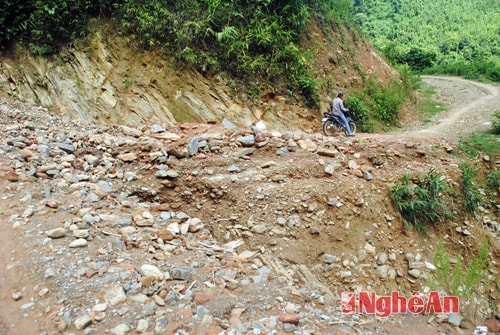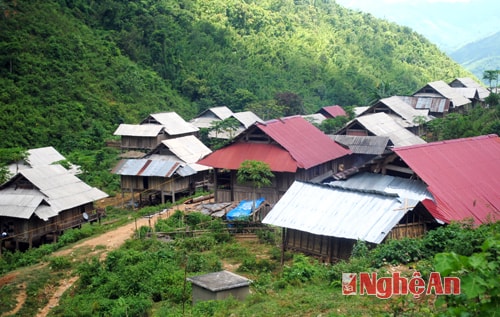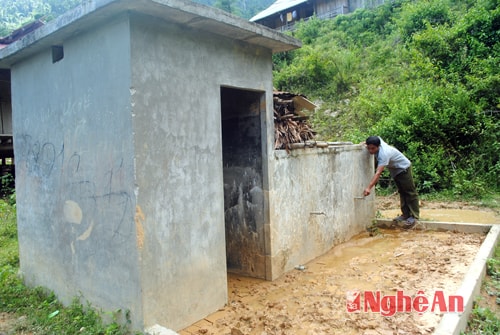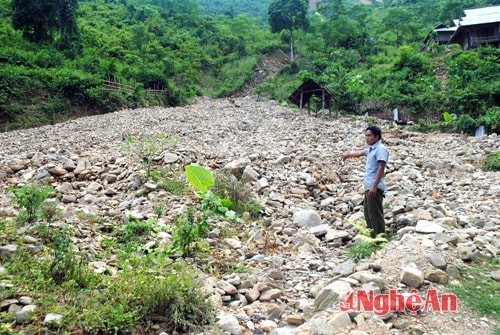"4 no's" in Ca Moong
(Baonghean) - Ca Moong village used to belong to Kim Da commune. Since the Ban Ve Hydropower Plant was built, Ca Moong people have resettled in Luong Minh commune, Tuong Duong district. After 4 years in the new land, Ca Moong village still has many shortcomings, negatively affecting the lives of 140 Khmu households here...
(Baonghean) - Ca Moong village used to belong to Kim Da commune. Since the Ban Ve Hydropower Plant was built, Ca Moong people have resettled in Luong Minh commune, Tuong Duong district. After 4 years in the new land, Ca Moong village still has many shortcomings, negatively affecting the lives of 140 Khmu households here...
Mr. Moong Van Thang's wooden boat, departing from the upstream ferry terminal of Ban Ve Hydroelectric Reservoir, took us to Ca Moong village, Luong Minh commune, Tuong Duong district on a morning at the end of July. On the boat were also 6 women from Thanh Son commune, Thanh Chuong district, who were coming to their hometown to pick bo bo.
 |
| Road to Ca Moong village. |
Before arriving at Ca Moong, we were told by some Ca Moong villagers who worked as boat drivers: “Journalists, go there and see, landslides have buried many houses”. After 50 minutes of motorboating up the lake, we landed at Ca Moong wharf. We had to hire an “iron horse” to overcome about 3 km of steep, rocky road, with cliffs on one side and deep abysses on the other. Occasionally, we came across motorbikes lying on both sides of the road. According to the villagers, these were motorbikes of Ca Moong villagers, abandoned for a long time. Arriving at the village around 10 am, Ca Moong village was deserted because people were busy weeding the rice fields or going into the forest to pick corn. Moong Van Vinh (village deputy), who had just returned from fishing in the lake, enthusiastically invited us to his house for a drink, then confided in us the problems that the villagers were having that had not been resolved for a long time. It is a "4 no" situation: no electricity, no road, no water for daily use, no land for production and especially the "hottest" thing is that many houses have had rocks and soil washed into them, making them uninhabitable!
 |
| A corner of Ca Moong village. |
Having said that, Mr. Vinh led us around the village. At this time, every house had smoke rising from the wood stove to dry the corn. The first issue that the copy mentioned to the reporter was the self-flowing water system. Although in 2011, the village received investment from the Ban Ve Hydropower Project to build a domestic water system for the people, including 15 water tanks. After only 1 month of use, most of the tanks had no water. The reason was that the water pipes were damaged. There were technical staff who came to check, but only treated the upstream. For a long time now, there are only 2 upstream tanks with water, the remaining 13 tanks do not have a drop of water. Observing, we saw that the water tanks here were covered with mud, and there were even tanks where buffalo, cows, and pigs defecated, causing unsanitary conditions. Without domestic water, the Ca Moong people had to use plastic cans to get water from the stream and carry it home for daily use.
 |
| The water tank has been abandoned for many years. |
Walking on the village roads, Mr. Vinh was upset, saying that there was no road was right, because of resettlement, the village roads like this were unacceptable. They should have built concrete roads for the people to enjoy, but they only built a section of about 200 meters, connecting from Ca Moong wharf to the village, the rest was dirt and stone roads, in the rainy season, people could only walk. Many families saved money to buy motorbikes, but the roads were too difficult, and the motorbikes soon broke down. Traffic was difficult, every day people wanted to go to the market or to Hoa Binh town, they had to take a boat on Ban Ve lake, which was both time-consuming and expensive. Mr. Vinh said: “Even for village cadres like us, every time we go to a commune meeting, we have to have at least 400,000 VND to dare to go. Of which, the motorbike taxi fare from the village to Ca Moong wharf costs 50,000 VND, the boat fare from the village wharf to the commune wharf is 30,000 VND, and the motorbike taxi fare from the wharf to the commune center is 70,000 VND. Doubled for both ways is 300,000 VND, not including food and drink.
Stepping on the rocky beach near the end of the village, looking towards the top of the hill, where the construction unit is opening a road connecting Coi village to Ca Moong village, Mr. Vinh said: That is the inter-commune road, after completion, Ca Moong people will no longer need a boat to go back to the commune. However, since the construction of this road (2 years ago), the soil and rocks from the project, following the flood water, have flowed down from above to the village, burying many houses, forcing some families to close their houses and set up huts in their old fields. Observing, we saw that on this 500 m2 wide land and rocks, there were still wooden stairs left by the people, like traces of the flash flood that had just passed. Mr. Vinh added: This land used to have 5 families living on it, including Moong Van Tien, Moong Van Oanh, Moong Duy Nghia, Oc Tinh Nghiep, Cut May Ky and Cut Van Dong. After several rainy and flood seasons, rocks and soil have flowed down, filling up the underside of houses, and completely burying pig and chicken pens. Too frustrated, the villagers have repeatedly complained to the commune and district, but no one has paid attention to solving or remedying the situation. If this situation continues, they fear that in the coming rainy and flood season, many more families will have rocks and soil washed into their homes. Mr. Cut Van Lien, whose house is close to the area where rocks and soil have flowed down, worries: Every time there is heavy rain, the water from the top of the mountain carries rocks and soil down with it. At times like that, the whole family is afraid and cannot sleep. Now, Mr. Lien's family picks up each rock and arranges them into a barrier across the river, in case of heavy rain.
 |
| Buried by landslides and rocks, many residents had to move elsewhere. |
It has been 4 years since moving to the new place, but up to now, the people of Ca Moong still do not have land for production. There is no other way, they have to go to the swidden area in the old village, more than 4 km from the new village to grow rice and corn. There is a lot of land around the village, but it is under the management of the protective forest. The villagers want to have swidden fields near their homes for convenient production, but they have not been concerned about it yet. The swidden fields in the old village are far from the river and the ferry, so people have to use small boats to swim upstream of the Ban Ve Hydroelectric Lake to go to work, which is dangerous to their lives during heavy rains and strong winds. Lacking land for production, people's lives are even more difficult, in the village there are currently 131/140 poor households.
Even the people of Ca Moong have not benefited from the national grid. Those households with the means have installed mini generators to provide electricity for lighting and small screens. However, during the rainy season, the stream water washes away the generators, and they have to be replaced every year. Most families with difficult economic conditions have to live in the dark at night, and people have little access to information sources, so the policies of the Party and the State do not reach the people.
Mr. Nguyen Van Thang - Deputy Head of the Department of Industry and Trade of Tuong Duong district, said: "Recently, we went to survey the scene of the landslides in Ca Moong village. What the people mentioned was correct. We determined that the landslides in the village were due to the amount of landslides cleared from the construction of a road connecting Coi village to Ca Moong village. In reality, it is very difficult for the people of Ca Moong village to stabilize their lives in their current place because there are still too many problems. After the survey, we reported to the District People's Committee for a solution..."
The frustrations of the Ca Moong people are not something that the local government has just now become aware of. For many years, the people have been petitioning and making suggestions to higher authorities. However, it is unclear why, up to now, no level or sector has paid attention or resolved them. When the Ban Ve Hydropower Project has shown little concern for the resettled people of Ca Moong, the local government needs to soon have a suitable plan to help the people stabilize their lives!
X.Hoang - H.Phuong






